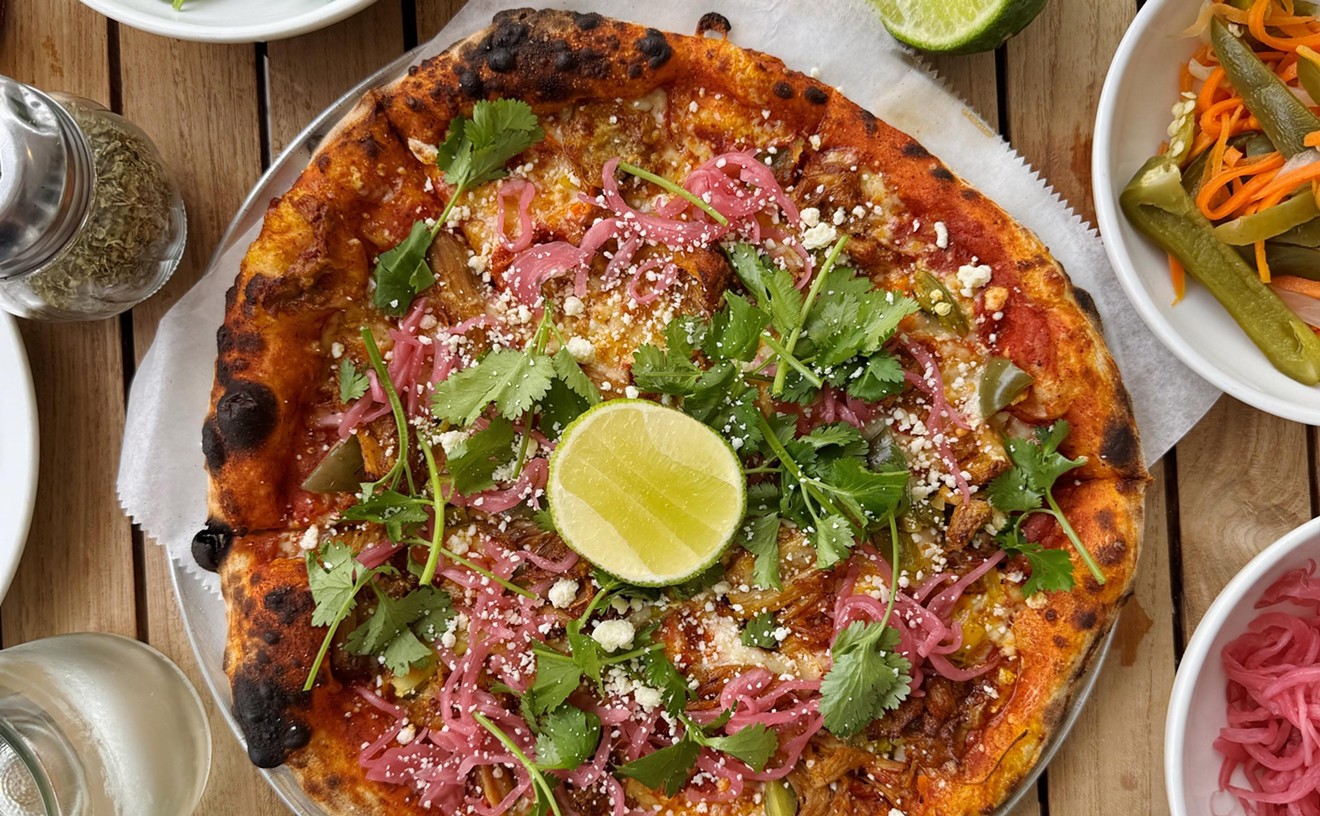The former Yuca chef-partner and originator of nuevo cubano cuisine could have easily suffered from small fish/big pond syndrome when he left the restaurant in 1993 to start his own operation. Though he'd looked at several possible sites in Miami, including the former Gatti location that Debbie Ohanian and Kerry Simon eventually remade into Starfish, Rodriguez took what some considered to be an unnecessary risk: He opened his three-tiered, tropically influenced eatery Patria in New York City.
A favorite figure on the budding New World food scene and a man oft-credited with revitalizing fine dining here in Miami, Rodriguez had good reason to be nervous about how he and his eclectic brand of cookery would fare in that notoriously tough town. Patria's posh Park Avenue address, where celebrated chefs such as David Burke (of the Park Avenue Cafe) have set up their kitschy kitchens, promised Rodriguez a healthy dose of competition. Plus, the Caribbean and Latin American populations in Manhattan are infinitely less varied than those in Dade. Though not everyone loved Rodriguez's brash recipes -- even here in the Magic City, the chef had as many traditionalist detractors as he had fans -- your average subtropical Joe was more likely to recognize his ingredients. Stir into the mix Rodriguez's personal feelings for Miami (of Cuban-American descent, he says he has returned about twenty times since he left to "drink coffee and talk Cuban stuff"), and the varnished-wood, wrought-iron-railed, commissioned-mural Patria seemed a recipe for failure.
Then again, it could be I'm just jealous because they've got him and we don't. Rodriguez's originality assures that he will never be overlooked; his Johnson & Wales-trained talent delivers. The eighteen-month-old Patria (literally fatherland) received raves from both the New York Times and New York magazine, as well as a special mention in Zagat, the culinary bible of many Big Apple eaters. And if local foot traffic still comes through the doors expecting tortilla chips and ordering margaritas, then that's nothing more than Rodriguez expected. "It's a slow education process for New York," he says. He, along with his pastry-chef-turned-publicist wife Patricia and maitre d'/sommelier Ariel Lacayo are happy to steer the misguided toward the promised land of plantain chips and mojitos. Or toward the sweet cream butter dotted with caramel-colored cloves of roasted garlic, which is served at the start of the meal in a cast-iron mortar (complete with pestle) along with warm rolls.
Rodriguez's focus has changed somewhat since he departed Miami. "Yuca was about nuevo cubano," he says. "Patria is nuevo latino," a label with which Rodriguez is so comfortable that he's used it to title his first cookbook (due out in October in an English and a Spanish version). Expanded horizons allow him to reinterpret the national specialties of the many Central and South American nations he toured before Patria's February 1994 opening, and to continue with his Cuban and Caribbean experimentations. At any given moment, for instance, up to five styles of empanadas might be on the appetizer list; arepas, ceviches, and tamales are also offered in variations. We liked best an arepa-like Venezuelan empanada, a half-moon of thin white corn dough wrapped around a savory, not-quite-spicy filling of black beans and roasted corn. Griddled, the cake was placed on a mattress of shredded iceberg lettuce that had been dressed with a finely chopped tomato salsa. The combination of hot food served over a cool salad -- a Rodriguez trademark -- was refreshing.
We passed over a menu-listed clam tamal for a special, a plain tamal that had been steamed in plantain leaves then cut into honey-brown halves and layered over a grouping of roasted vegetables. Wedges of malanga and yuca alternated with spears of baby asparagus, all of which had been candied with beets. The resulting sweet-and-sourness was a tantalizing contrast to the ground-corn dough. A verdant tangle of watercress and alfalfa sprouts capped the dish.
A take on architectural presentations, a cured beef roll was a startling teepeelike construction. A timbale-shape mold of delicious white bean salad served as the base for the roll's four spears, which were angled on the just-tender beans and arranged to come to a point. The roll itself was a crisp layer of plantain stuffed with tasajo, the Latin-recipe salt-dried beef. Of flank steak consistency, the beef counterpointed the sweeter plantain perfectly. -- smoky chipotle "ketchup" emanated in waves from the structure the way ripples spread from a pebble thrown into a pond.
Like the appetizers, entrees were served on oversize glass plates of varying colors and shapes. The overwhelming length of the churrasco Lacayo practically demanded the platter on which it was served. Tender as a love song, the Nicaraguan-style boneless beef loin was of the high quality one has come to expect from that nation's meat. Three flavors -- a traditionally parsley-heavy chimichurri, pungent black beans, and a ruby beet relish -- garnished the meat.
Guatemalan chicken seemed a natural segue. The breast meat, sliced and fanned over patacones (thin cakes made from plantains), green rice, and avocado salad, made a lovely arrangement, right down to the deep-fried drumstick sticking up out of the rice. With the exception of that drumstick, the poultry was a bit too dry, possibly because we requested the accompanying mole sauce on the side. Rather than the bittersweet chocolate-based Mexican sauce, this mole was a crimson chili pepper brew that packed a powerful, if not especially piquant, punch. The buttery rice was nicely flavored with cilantro and scallions, and the avocado salad was an ideal preparation, bursting with the ripe fruit. We also sampled a side dish of black beans and rice that were as wonderful as any in Miami.
One of the most interesting combinations of the evening paired bananas with green lentils; the al dente legumes were enhanced greatly by the unmistakable fragrance of the tropical fruit. Two oyster croquettes, dense and spicy, rested on the salad. But the top layer of this main course took most of our attention. A two-inch-thick swordfish steak comparable to the size and structure of filet mignon crowned the lentils and croquettes, nearly to their detriment -- the fish was so fabulous you had to force yourself to care about the side dishes served with it. Juicy, it fell away in firm flakes to be dipped in a decorative horseradish cream that dotted the plate, each hefty forkful a pleasure to all the senses. Aside from the swordfish, I truly admired one very telling aspect of this entree: Though Rodriguez indulges a penchant for combining hot foods with cold -- not only on the same plate but on top of each other, he manages to keep them at their proper temperatures. The swordfish was served steaming, the lentils were still cool. Given the 105 seats of Patria -- all of which, according to Rodriguez, are usually filled three times per night -- this is no small task. Indeed, I would attribute the restaurant's popularity in part to the soothing summery appeal of grilled meats and fish over salsas and salads; on an August evening when half the town is on Long Island and the other half is at the movies, Patria still pulls them in.
Another way to cool off at Patria is to order pastry chef Sonia Urban's homemade sorbets and ice creams. We were lucky enough to dine on the very evening when she unveiled several new desserts. Topped with poached cherries and a tart cherry-vanilla swirl of ice cream, "cherry blackout" comprised triangles of a rich torte of white chocolate and chocolate chips. As a way to beat the heat (which, may my family forgive me, New Yorkers complain about incessantly), it's right up there with a house in the Hamptons. And far better than a municipal fire hydrant.
Success for Rodriguez doesn't mean we've lost him -- or his New Latin cuisine -- forever. Patria is a natural destination location for those who occasionally foray to the big town. For those who stay put, we still have Yuca, whose kitchen carries on under Rodriguez protege Guillermo Veloso (and is persistently rumored to be relocating to Lincoln Road's as-yet-unfinished Sony building). The "Manhattan Latin's" book tour will bring him back to us sometime in the fall; friends in the business such as Rolf Gerstner (the owner of Coral Gables's Culinary Bazaar, who supplied Patria with its mortars and pestles) will keep him visiting year-round. And though a second, downscaled restaurant in New York City will probably be his next project, he says that opening a place in Miami in the near future is a very "real possibility." In fact, after telling me that he's already turned down several propositions, including one on Ocean Drive and another in Coral Gables, he began quizzing me about the newest places to dine here, with equal parts nostalgia and entrepreneurial interest.
Please: Somebody make him an offer he can't refuse.









